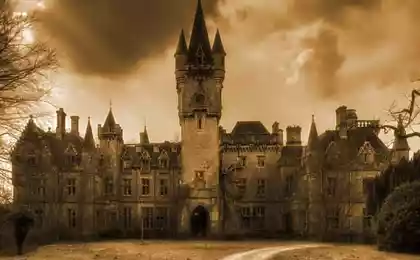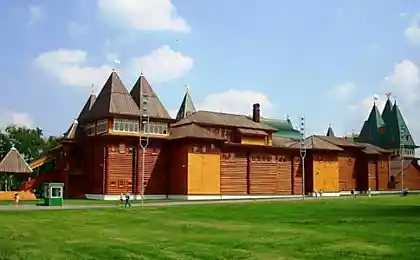2680
Palaces and castles of England - Leeds (Leeds Castle) (64 pics + 3 videos)
Leeds Castle is located on the 2-lake islands along the River Len (River Len) about 4 miles from Meydstuona in Kent.
This - a medieval fortress, classified as one of the most beautiful castles in the world

Rich in history and events of the castle, which is often to be found in history, and which is closely connected with the history of England. The very name of Leeds Castle was the name of its first owner - Senora Lida. It was he who in 857 was built in this place a small wooden fortress. The first evidence of the castle date back to the end of XI century. Then in England conducted a census of land, population Leeds and other general information about the city. All collected data were entered in the Domesday Book (or as it is called - "Book of Judgment Day», «Domesday Book») - a set of information, the first European medieval census, which was carried out in England in 1085 for 1086 under the leadership of William the Conqueror .
In place of the wooden building in 1119 Robert de Kreveker erects a stone castle. In 1278 the castle was much altered by Edward Longshanks, it was a gift for his wife, Eleanor of Castile. Until 1318 the castle was the property of widowed queens of England. For example, it has long lived Margarita French. Edward II after the death of her stepmother changes Leeds Castle Adderley, located in the county of Shropshire. Then the estate belonged to Lord Bartolomeo Badlsmiru.
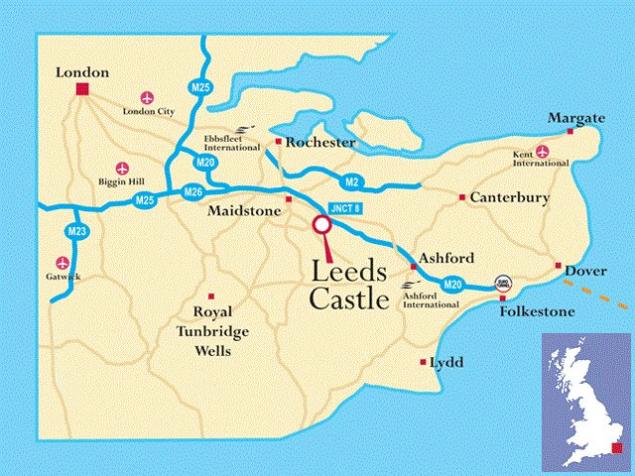
Its location meant that supplies and reinforcements in times of war could be delivered on time and smoothly along the river, thus avoiding the threat of famine for the garrison. Leeds was a royal palace that belonged to the crown in 1278 to 1552 years; he frequented in the Middle Ages, kings and queens of England.
The castle consists of four forts, each of which was capable of self-defense. At the entrance, very near to the coast, is the Barbican Gate tower. Stone Bridge, through which you walk to the castle was originally a wooden drawbridge. Gate tower looks like it would have looked in the 13th century, when it served as a room for servants and horses, as well as it is a significant defensive fortification. The central island was surrounded by a stone wall, which reached a height of fifteen feet. Here are the tower and the commandant of a modern palace. To the south of this island are two defensive towers; Maiden Tower (Maiden's Tower) and a water tower.

Medieval citadel, known as the Gloriette in memory of the Queen Elinor (Queen Eleanor), located on the smaller of the 2-islands. Built by King Edward I, it consists of a formed as a D symbol tower, which contained a large hall and living quarters. In addition to its unique architecture, interiors and royal treasures of family, Leeds Castle is famous 500 acres of landscaped parkland that surround it and include a maze, an aviary, a grotto and a vineyard. Leeds Castle is supported by the Leeds Castle and is open to the public since 1976.
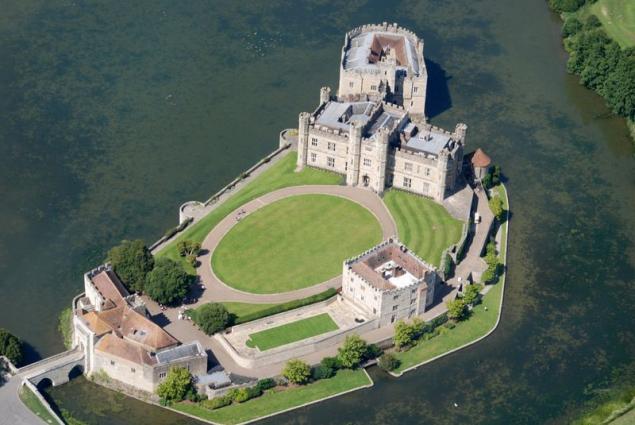
In 1119, Robert de Kreveker (Robert de Crevecoeur) began construction of a stone fortress on the site where there were early Saxon earthwork.
A short time later, the castle is mentioned in the history of the struggle for the English throne between Stephen and the Empress Matilda Bluaskim. Leeds Castle, at the time owned by Robert, Earl of Gloucester, who was a half brother of Matilda. With his support, in 1139 Matilda invaded England. However, Kent was loyal to Stefan and after a short siege, he gained control of the fortress.

In 1278 castle came under the control of King Edward I. He became his primary residence and Elionry Castile (Eleanor of Castile). During this time, the fortress was made a number of improvements, including the construction of the main citadel, the Barbican and walls.

In the fall of 1321 Queen Isabella on the road to Canterbury I wanted to stay in Leeds. But while the owner of the castle, Lord Badlsmera, was not at home, but his wife refused to take the queen. Some of the guards were killed Isabella, trying to break through the walls of Leeds. Already in October 1321 in response to such an insult to Edward II took the castle, family (including his wife Badlsmera) arrested and sent to the Tower of London. Frightened by the bitter fate of the defenders of Leeds, the garrisons of other castles, the owner of which was Badlsmer, surrendered themselves to the king.
It is estimated that in 1321 the castle was presented to Queen Isabella. The documents also say more that the castle became the property of the queen only in 1327. Henceforth lock nobody else exciting, many centuries it remained the residence of the king of England.

In 1381, Anne of Bohemia (Anne of Bohemia) wintered in the castle before her marriage with King Richard II.
In 1395 Richard II met in the castle with the French chronicler Jean Froissart, who wrote about the meeting in his "Chronicles." When the owner of the castle became Henry VIII, he changed the lock especially for his beloved wife, Catherine of Aragon. In Leeds you can see paintings depicting the meeting of Henry VIII and King Francis I. time here in prison was the future Queen of England - Elizabeth.
Leeds Castle has also become a favorite of King Henry VIII and Catherine of Aragon (Catherine of Aragon). Henry VIII transformed the building into a royal palace, adding to its exterior set ups Tudor style, which we can see today.

Ultimately, the castle was given to one of the court of King Henry in private ownership King Edward IV. Since then, Leeds Castle is private.
Leeds Castle survived the English Civil War, without suffering damage as a family Culpepper (Culpepper), which he belonged, was on the side of parliamentarians. During the 17th century the main citadel was used as a jail for prisoners from France and Holland. However, after the prisoners had set up in her fire, the prison has ceased to exist.
In 1926, Lady Olive Baillie (Lady Olive Baillie), American heiress bought a chateau near Vaykhema Martins (Wykeham Martins). It completely transformed its interior decoration, and later established the Leeds Castle Foundation.

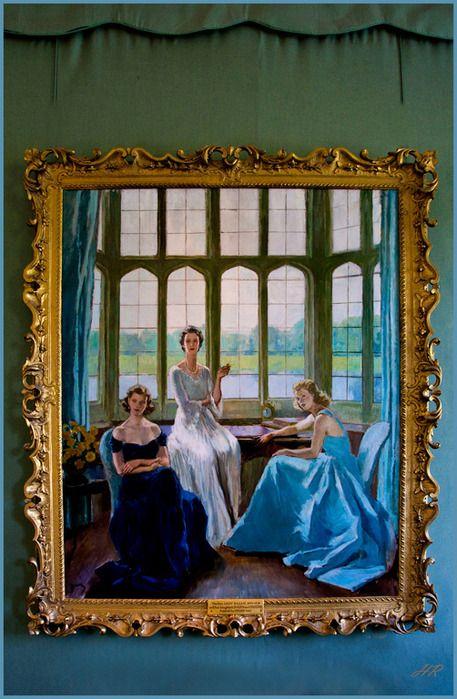
Sluchiloch so that in 1926, Olive Wilson Filmer (Olive Wilson Filmer), later became Lady Baillie, as well as six medieval queens of England, came under the magical effect of Leeds Castle.
Lady Baillie's mother Pauline Whitney, was a rich American socialite lady, and her father Almerik Paget was a British aristocrat, Lord Kuinboro last. After moving to England Bailey Olivia's mother, he has been known as the most successful woman in the hotel business. It is also famous for its fine collection of paintings and decorative furniture. Pauline Whitney died when Olive was only 17 years old.
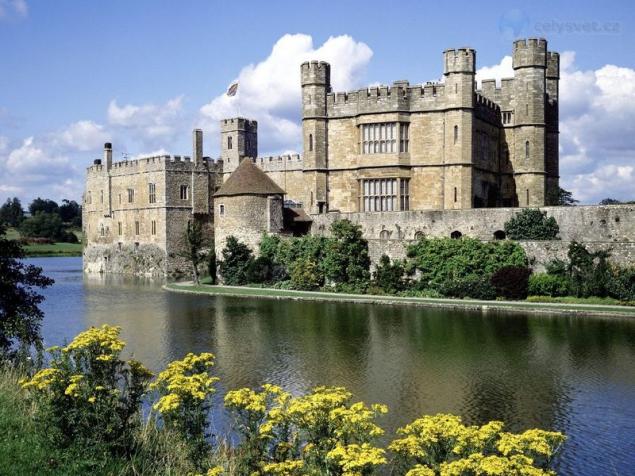
Having inherited a large fortune of his mother, as well as other wealthy relatives, Oliva could look with confidence to the future. In 1919 she married Charles Wynne respected. From this marriage she had two daughters Pauline and Susan. The marriage was dissolved in 1925, and Oliva became Mrs. Arthur Wilson Filmer, marrying the nephew of Sir Robert Filmer.
Through this marriage Oliva family which had intermarried with Kent roots and owned an estate in the neighborhood of East Sutton Park. It thus satisfied the requirements put forward by the seller Leeds Castle Wykeham Martin Fairfax (Fairfax Wykeham Martin) to potential buyers.

Through this marriage Oliva family which had intermarried with Kent roots and owned an estate in the neighborhood of East Sutton Park. It thus satisfied the requirements put forward by the seller Leeds Castle Wykeham Martin Fairfax (Fairfax Wykeham Martin) to potential buyers.
She invited the best architects and interior designers, has completely changed the interior of the castle. Renowned architect Armand-Albert Rateau worked not only with the appearance of the castle, but also to the situation in, for example, he set in the castle oak staircase in the style of the XVI century. Later he worked in Leeds French specialist decor - Stephane Boudin. Lady Bailey over the years gathered in the castle various collections of furniture, ceramics, paintings and precious porcelain. She restored the royal apartments and the royal bathroom - they are made in the style of early XV century in the style of the time of Catherine of Valois, wife of Henry V. Also, Lady Bailey established the Leeds Castle Foundation, which raises funds for the improvement, development and overall content of the castle and a huge park and Garden adjacent to the castle.

In 1931 Oliva marries Sir Adrian Baillie (Sir Adrian Baillie), and in 1936 it hired a French decorator, Stefani Budina (Stéphane Boudin), which took up most of the decoration of the castle interiors. In addition to the restoration of the building of the castle and do not forget to carry out landscaping of the park. Lady Baillie contributed tab beautiful park Wood Garden. The adjacent area equipped with a golf course, a swimming pool and tennis courts, which undoubtedly is a great pleasure as a family and numerous guests attending receptions are held in the castle.
His last years Lady Baillie spent with his family, still decorate the castle. She died in 1974, bequeathing all Leeds Castle nation, and laid in the custody of the castle Charitable Fund Castle Leeds (Leeds Castle Foundation).

Since 1976, the complex is open to the public. The tour includes a visit to the castle of the old buildings Glorieta, named in honor of Eleanor of Castile. Dog lovers will be interested in the unique museum of collars. Also of interest are especially Culpepper English garden, which is located several cages of exotic birds, including the rare black swans, wild gardens, a grotto and a maze of green. There is even a public 9-hole golf course.
Leeds provides a venue for many events in the county of Kent in England. The castle can be booked for conferences, weddings and other private collections. On the first Saturday of each month caretaker throwing a party with cocktails and refreshments from five dishes for private groups. In June and July there are large open-air concerts.
Leeds Castle in England, perhaps not so well known as the Windsor Castle or Buckingham Palace, but his romantic beauty has no equal among ancient British buildings.

Leeds is 60 km from London, so it can be easily reached by train (station 6 km) or take a taxi. The complex is open daily from 10:00 to 17:00 (in winter until 15.00). Entrance for adults - £ 18.50, children under 15 - £ 11.00 Official website: www.leeds-castle.com a >

While in England worth a visit Leeds Castle, you can see: for lovers of nature - "a living labyrinth" of 3 thousand yews; for bird lovers - a huge aviary where you will be able to see more than a hundred of rare and exotic birds; and for those who love the "four-legged friends", there is also a museum of dog collars, which exhibited a collection of collars of the XV century of our time.
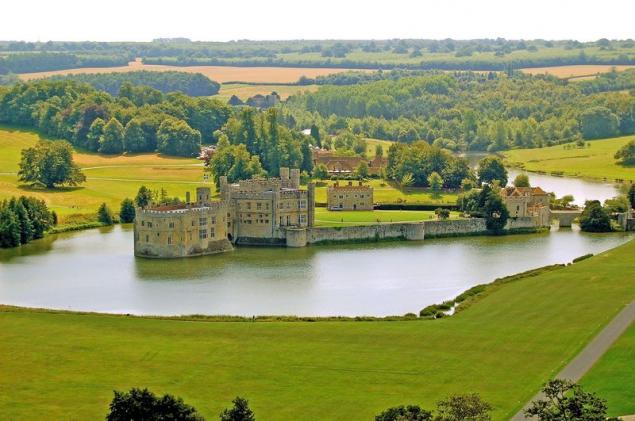
In addition to paintings, upholstery, furniture and ceramics exhibited in the castle unique collection of antique dog collars.
Gardens: The huge park surrounding the castle, was created in the early 18th century. Many trees planted at the time, survived. The park is divided by rivers and lakes, which occupies more than 30 species of waterfowl. There is also a beautiful garden, it is especially beautiful in spring when the daffodils bloom. In addition, the Leeds castle contains a collection of national Bergamot.
The garden is also an aviary inhabited by rare and endangered species of birds from around the world.
It will be interesting to look at yew maze. Bushes trimmed so that they resemble castle. Inside the maze there is a secret grotto.
Leeds Castle vineyard used to make wine.
All year round in the castle are special events such as the Balloon Festival, outdoor concerts, vintage car rally, fireworks show.
Contacts: Leeds Castle Enterprises Ltd., Maidstone, Kent, ME17 1PL
Phone: +44 (0) 1622 765 400




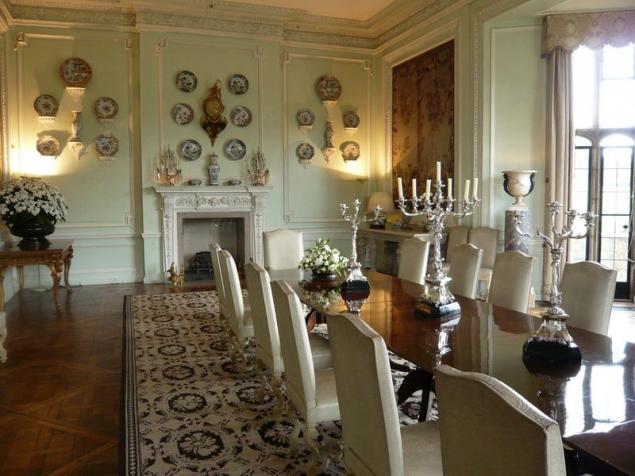
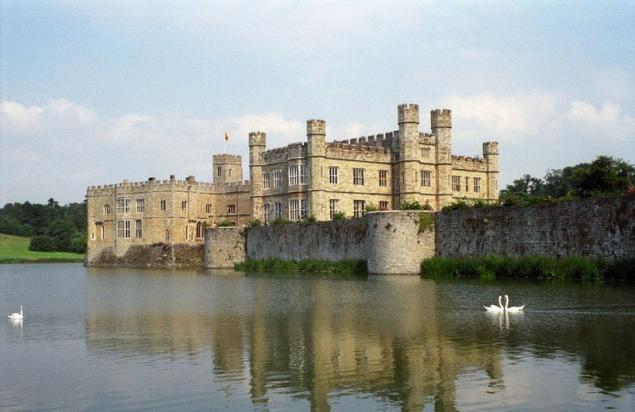

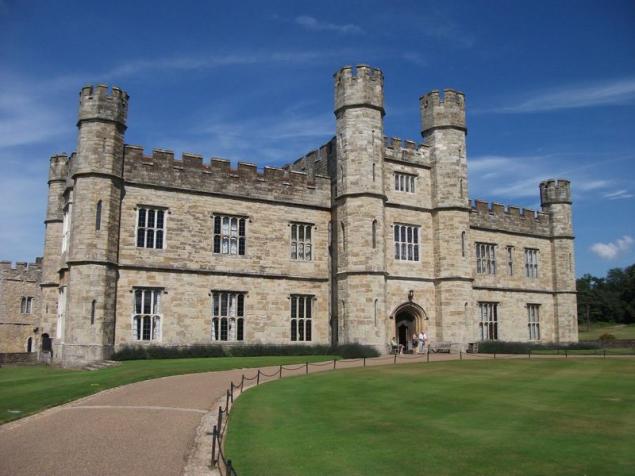

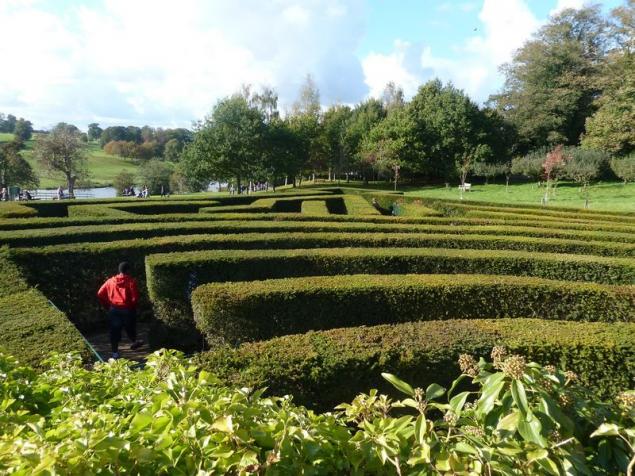


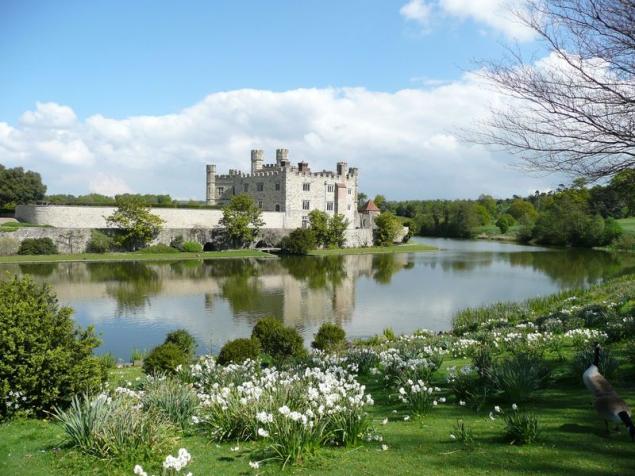
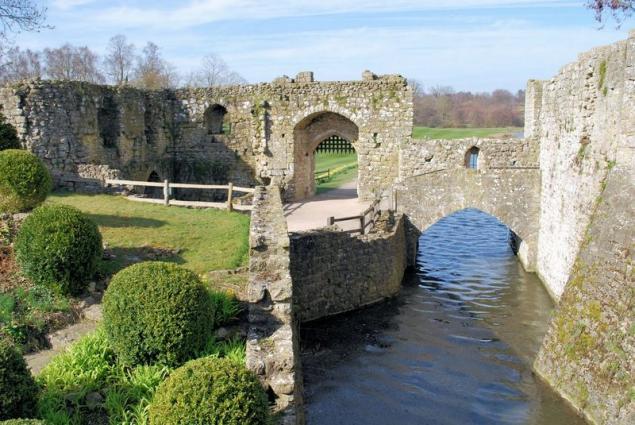




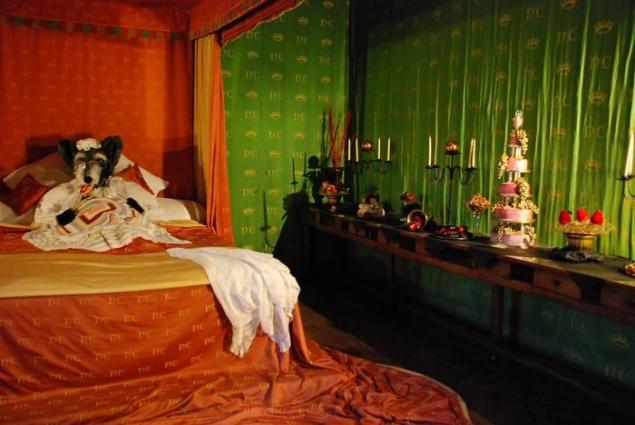





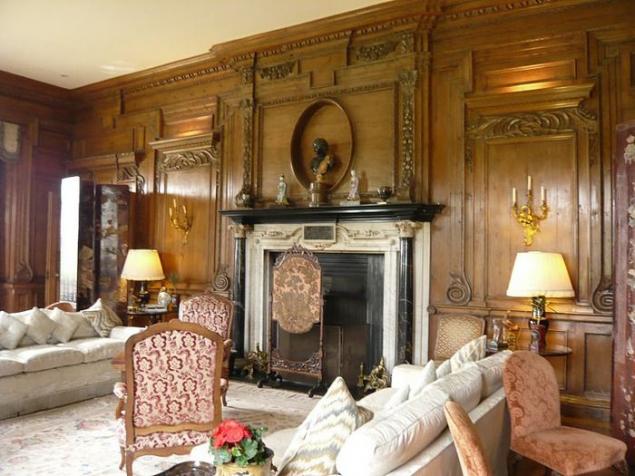


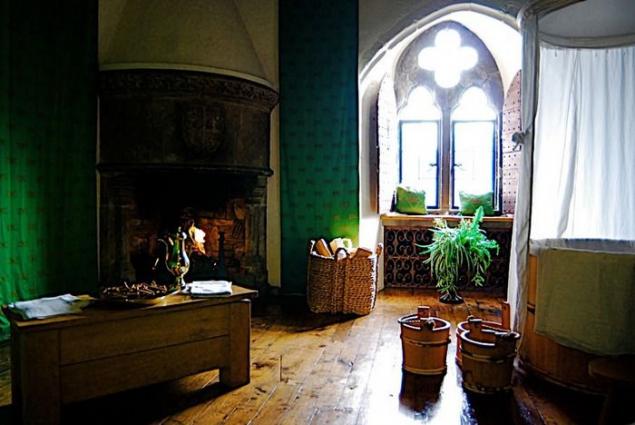





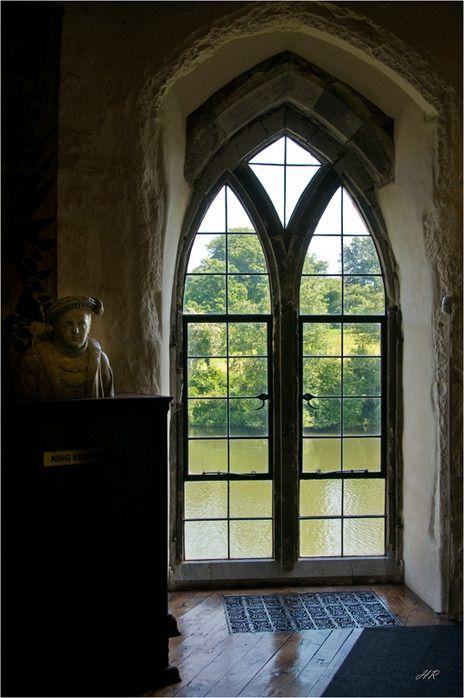













Source: masterok.livejournal.com, www.londoninfocus.com , allcastle.info, www.caslall.ru
This - a medieval fortress, classified as one of the most beautiful castles in the world

Rich in history and events of the castle, which is often to be found in history, and which is closely connected with the history of England. The very name of Leeds Castle was the name of its first owner - Senora Lida. It was he who in 857 was built in this place a small wooden fortress. The first evidence of the castle date back to the end of XI century. Then in England conducted a census of land, population Leeds and other general information about the city. All collected data were entered in the Domesday Book (or as it is called - "Book of Judgment Day», «Domesday Book») - a set of information, the first European medieval census, which was carried out in England in 1085 for 1086 under the leadership of William the Conqueror .
In place of the wooden building in 1119 Robert de Kreveker erects a stone castle. In 1278 the castle was much altered by Edward Longshanks, it was a gift for his wife, Eleanor of Castile. Until 1318 the castle was the property of widowed queens of England. For example, it has long lived Margarita French. Edward II after the death of her stepmother changes Leeds Castle Adderley, located in the county of Shropshire. Then the estate belonged to Lord Bartolomeo Badlsmiru.

Its location meant that supplies and reinforcements in times of war could be delivered on time and smoothly along the river, thus avoiding the threat of famine for the garrison. Leeds was a royal palace that belonged to the crown in 1278 to 1552 years; he frequented in the Middle Ages, kings and queens of England.
The castle consists of four forts, each of which was capable of self-defense. At the entrance, very near to the coast, is the Barbican Gate tower. Stone Bridge, through which you walk to the castle was originally a wooden drawbridge. Gate tower looks like it would have looked in the 13th century, when it served as a room for servants and horses, as well as it is a significant defensive fortification. The central island was surrounded by a stone wall, which reached a height of fifteen feet. Here are the tower and the commandant of a modern palace. To the south of this island are two defensive towers; Maiden Tower (Maiden's Tower) and a water tower.

Medieval citadel, known as the Gloriette in memory of the Queen Elinor (Queen Eleanor), located on the smaller of the 2-islands. Built by King Edward I, it consists of a formed as a D symbol tower, which contained a large hall and living quarters. In addition to its unique architecture, interiors and royal treasures of family, Leeds Castle is famous 500 acres of landscaped parkland that surround it and include a maze, an aviary, a grotto and a vineyard. Leeds Castle is supported by the Leeds Castle and is open to the public since 1976.

In 1119, Robert de Kreveker (Robert de Crevecoeur) began construction of a stone fortress on the site where there were early Saxon earthwork.
A short time later, the castle is mentioned in the history of the struggle for the English throne between Stephen and the Empress Matilda Bluaskim. Leeds Castle, at the time owned by Robert, Earl of Gloucester, who was a half brother of Matilda. With his support, in 1139 Matilda invaded England. However, Kent was loyal to Stefan and after a short siege, he gained control of the fortress.

In 1278 castle came under the control of King Edward I. He became his primary residence and Elionry Castile (Eleanor of Castile). During this time, the fortress was made a number of improvements, including the construction of the main citadel, the Barbican and walls.

In the fall of 1321 Queen Isabella on the road to Canterbury I wanted to stay in Leeds. But while the owner of the castle, Lord Badlsmera, was not at home, but his wife refused to take the queen. Some of the guards were killed Isabella, trying to break through the walls of Leeds. Already in October 1321 in response to such an insult to Edward II took the castle, family (including his wife Badlsmera) arrested and sent to the Tower of London. Frightened by the bitter fate of the defenders of Leeds, the garrisons of other castles, the owner of which was Badlsmer, surrendered themselves to the king.
It is estimated that in 1321 the castle was presented to Queen Isabella. The documents also say more that the castle became the property of the queen only in 1327. Henceforth lock nobody else exciting, many centuries it remained the residence of the king of England.

In 1381, Anne of Bohemia (Anne of Bohemia) wintered in the castle before her marriage with King Richard II.
In 1395 Richard II met in the castle with the French chronicler Jean Froissart, who wrote about the meeting in his "Chronicles." When the owner of the castle became Henry VIII, he changed the lock especially for his beloved wife, Catherine of Aragon. In Leeds you can see paintings depicting the meeting of Henry VIII and King Francis I. time here in prison was the future Queen of England - Elizabeth.
Leeds Castle has also become a favorite of King Henry VIII and Catherine of Aragon (Catherine of Aragon). Henry VIII transformed the building into a royal palace, adding to its exterior set ups Tudor style, which we can see today.

Ultimately, the castle was given to one of the court of King Henry in private ownership King Edward IV. Since then, Leeds Castle is private.
Leeds Castle survived the English Civil War, without suffering damage as a family Culpepper (Culpepper), which he belonged, was on the side of parliamentarians. During the 17th century the main citadel was used as a jail for prisoners from France and Holland. However, after the prisoners had set up in her fire, the prison has ceased to exist.
In 1926, Lady Olive Baillie (Lady Olive Baillie), American heiress bought a chateau near Vaykhema Martins (Wykeham Martins). It completely transformed its interior decoration, and later established the Leeds Castle Foundation.


Sluchiloch so that in 1926, Olive Wilson Filmer (Olive Wilson Filmer), later became Lady Baillie, as well as six medieval queens of England, came under the magical effect of Leeds Castle.
Lady Baillie's mother Pauline Whitney, was a rich American socialite lady, and her father Almerik Paget was a British aristocrat, Lord Kuinboro last. After moving to England Bailey Olivia's mother, he has been known as the most successful woman in the hotel business. It is also famous for its fine collection of paintings and decorative furniture. Pauline Whitney died when Olive was only 17 years old.

Having inherited a large fortune of his mother, as well as other wealthy relatives, Oliva could look with confidence to the future. In 1919 she married Charles Wynne respected. From this marriage she had two daughters Pauline and Susan. The marriage was dissolved in 1925, and Oliva became Mrs. Arthur Wilson Filmer, marrying the nephew of Sir Robert Filmer.
Through this marriage Oliva family which had intermarried with Kent roots and owned an estate in the neighborhood of East Sutton Park. It thus satisfied the requirements put forward by the seller Leeds Castle Wykeham Martin Fairfax (Fairfax Wykeham Martin) to potential buyers.

Through this marriage Oliva family which had intermarried with Kent roots and owned an estate in the neighborhood of East Sutton Park. It thus satisfied the requirements put forward by the seller Leeds Castle Wykeham Martin Fairfax (Fairfax Wykeham Martin) to potential buyers.
She invited the best architects and interior designers, has completely changed the interior of the castle. Renowned architect Armand-Albert Rateau worked not only with the appearance of the castle, but also to the situation in, for example, he set in the castle oak staircase in the style of the XVI century. Later he worked in Leeds French specialist decor - Stephane Boudin. Lady Bailey over the years gathered in the castle various collections of furniture, ceramics, paintings and precious porcelain. She restored the royal apartments and the royal bathroom - they are made in the style of early XV century in the style of the time of Catherine of Valois, wife of Henry V. Also, Lady Bailey established the Leeds Castle Foundation, which raises funds for the improvement, development and overall content of the castle and a huge park and Garden adjacent to the castle.

In 1931 Oliva marries Sir Adrian Baillie (Sir Adrian Baillie), and in 1936 it hired a French decorator, Stefani Budina (Stéphane Boudin), which took up most of the decoration of the castle interiors. In addition to the restoration of the building of the castle and do not forget to carry out landscaping of the park. Lady Baillie contributed tab beautiful park Wood Garden. The adjacent area equipped with a golf course, a swimming pool and tennis courts, which undoubtedly is a great pleasure as a family and numerous guests attending receptions are held in the castle.
His last years Lady Baillie spent with his family, still decorate the castle. She died in 1974, bequeathing all Leeds Castle nation, and laid in the custody of the castle Charitable Fund Castle Leeds (Leeds Castle Foundation).

Since 1976, the complex is open to the public. The tour includes a visit to the castle of the old buildings Glorieta, named in honor of Eleanor of Castile. Dog lovers will be interested in the unique museum of collars. Also of interest are especially Culpepper English garden, which is located several cages of exotic birds, including the rare black swans, wild gardens, a grotto and a maze of green. There is even a public 9-hole golf course.
Leeds provides a venue for many events in the county of Kent in England. The castle can be booked for conferences, weddings and other private collections. On the first Saturday of each month caretaker throwing a party with cocktails and refreshments from five dishes for private groups. In June and July there are large open-air concerts.
Leeds Castle in England, perhaps not so well known as the Windsor Castle or Buckingham Palace, but his romantic beauty has no equal among ancient British buildings.

Leeds is 60 km from London, so it can be easily reached by train (station 6 km) or take a taxi. The complex is open daily from 10:00 to 17:00 (in winter until 15.00). Entrance for adults - £ 18.50, children under 15 - £ 11.00 Official website: www.leeds-castle.com a >

While in England worth a visit Leeds Castle, you can see: for lovers of nature - "a living labyrinth" of 3 thousand yews; for bird lovers - a huge aviary where you will be able to see more than a hundred of rare and exotic birds; and for those who love the "four-legged friends", there is also a museum of dog collars, which exhibited a collection of collars of the XV century of our time.

In addition to paintings, upholstery, furniture and ceramics exhibited in the castle unique collection of antique dog collars.
Gardens: The huge park surrounding the castle, was created in the early 18th century. Many trees planted at the time, survived. The park is divided by rivers and lakes, which occupies more than 30 species of waterfowl. There is also a beautiful garden, it is especially beautiful in spring when the daffodils bloom. In addition, the Leeds castle contains a collection of national Bergamot.
The garden is also an aviary inhabited by rare and endangered species of birds from around the world.
It will be interesting to look at yew maze. Bushes trimmed so that they resemble castle. Inside the maze there is a secret grotto.
Leeds Castle vineyard used to make wine.
All year round in the castle are special events such as the Balloon Festival, outdoor concerts, vintage car rally, fireworks show.
Contacts: Leeds Castle Enterprises Ltd., Maidstone, Kent, ME17 1PL
Phone: +44 (0) 1622 765 400















































Source: masterok.livejournal.com, www.londoninfocus.com , allcastle.info, www.caslall.ru
Apartment-transformer (17 pics + 1 video)
The consequences of an accident at a speed of 354 km / h (37 photos + video)




















